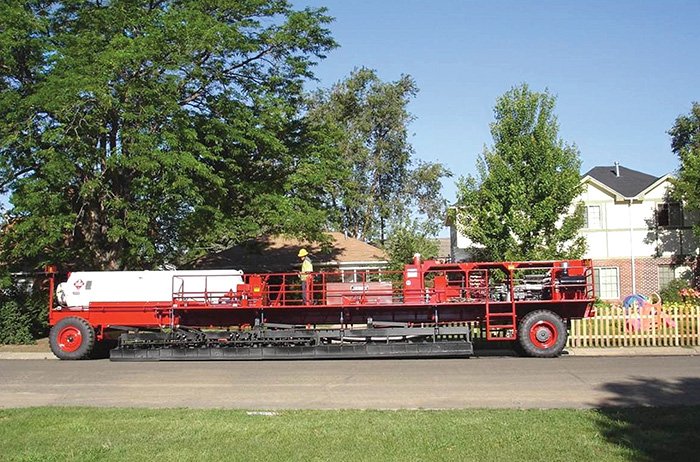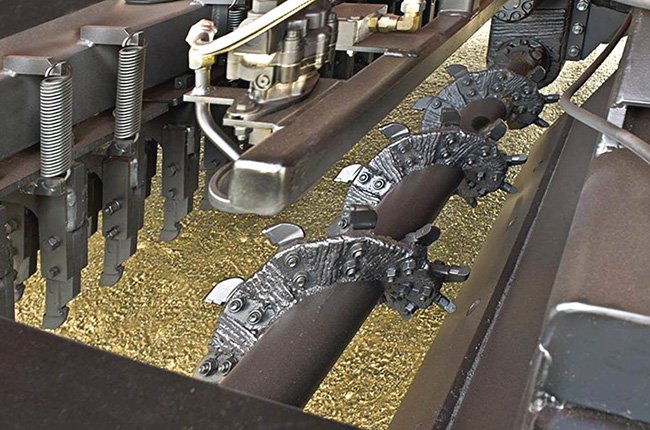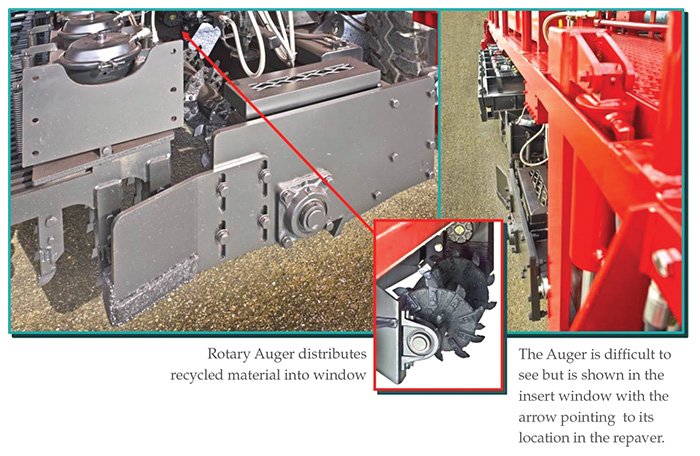 The use of Hot In-Place Recycling (HIR) in road construction is quite widespread in the United States. This article is a discussion about some experiences with this process over the last two decades and how this process and the associated equipment and work methods have evolved.
The use of Hot In-Place Recycling (HIR) in road construction is quite widespread in the United States. This article is a discussion about some experiences with this process over the last two decades and how this process and the associated equipment and work methods have evolved.
Past Experience
The idea of using HIR was originally known as Heater Scarification in the 1980’s timeframe. The concept was that, if the pavement (road) could be re-heated in a manner that would bring at least the top 1-2 inches to a temperature that would soften the mixture, it might be possible to drag some small ripper teeth in a linear array down the direction of the pavement and scarify the surface of the pavement so that it could be re-compacted and replaced and it would be somewhat restored in serviceability.
 The results were mixed due to the fact that an open flame was causing overheating of the surface and the equipment in use at that time had a limited contact time for the heat. This caused a delay in the time for the heat to penetrate adequately through the paved surface and the process was not as efficient as it could have been and the depth was limited to approximately 19-20mm (3/4 inch). The scarifiers were dragged along and cut the surface of the pavement and the pavement was re-compacted to provide an improved and somewhat refurbished pavement surface. The positive results of this process were a removal of cracking at the surface, refurbishment of the pavement to a limited degree and a “newer” look to the pavement surface and restoration of a good ride for commuters.
The results were mixed due to the fact that an open flame was causing overheating of the surface and the equipment in use at that time had a limited contact time for the heat. This caused a delay in the time for the heat to penetrate adequately through the paved surface and the process was not as efficient as it could have been and the depth was limited to approximately 19-20mm (3/4 inch). The scarifiers were dragged along and cut the surface of the pavement and the pavement was re-compacted to provide an improved and somewhat refurbished pavement surface. The positive results of this process were a removal of cracking at the surface, refurbishment of the pavement to a limited degree and a “newer” look to the pavement surface and restoration of a good ride for commuters.
However, there were some companies that met with good success using this process to assist highway departments and local government transportation agencies achieve a usable surface and to extend the life of the highway, albeit in a limited fashion and over a limited time. The extension achieved was perhaps 3-5 years at the best and often there was re-cracking of the road after 12-24 months.
However, many roads were recycled to provide more service and there was some success in keeping pavements operational that were near the end or at the end of their service life.
Overview of the modern HIR Process
 Pre-heating the Pavement: The older process, which was used in the 80’s, heated the pavement by a flame caused smoking, air pollution and extreme deterioration of the existing pavement surface. The more modern longer heating time and use of horizontal flame-heated radiant infrared heaters eliminates most of these drawbacks and give much deeper and more effective heating.
Pre-heating the Pavement: The older process, which was used in the 80’s, heated the pavement by a flame caused smoking, air pollution and extreme deterioration of the existing pavement surface. The more modern longer heating time and use of horizontal flame-heated radiant infrared heaters eliminates most of these drawbacks and give much deeper and more effective heating.
Scarification: The scarification process used in recent times has become much more effective and the depth of scarification has increased from about 19mm in the 1980’s to approximately 50mm in 2014. The use of a rotary scarifying drum increases the efficiency and the longer heating unit causes better thermal penetration into the pavement. This also causes the pavement to remain heated for some time which can greatly facilitate an overlay with a lower temperature mix such as Warm Mix Asphalt Concrete.
The appearance of the scarified asphalt is immediately changed during the scarification process. The pale oxidized surface appearance is replaced by a more active asphalt material surface which contains more of the higher fractions of the original asphalt and enables a better bonding opportunity for new recycling agents or new asphaltic cement to be added to the mix. This also eliminates any surface cracking and automatically cuts away & eliminates any rutting or unusual surface undulations that might contribute to a rougher ride for the travelling public. This is greatly facilitated by the length of the paving train. The length of the machines determines the distance over which the undulations are integrated thereby greatly reducing pavement waviness from earlier paving operations or uneven localized settlement or any other elevation difference that have resulted from whatever initiating cause.
Hot-in-place process is quite cost effective. The ride and surface appearance are good when the paving is complete. The rapid paving process results in low impact on moving traffic compared to conventional paving jobs and using a sustainable process leads to better future availability of the asphalt raw material. This process uses less heat, less material, generates less greenhouse gas, and produces good structurally sound results.
 Re-spreading As the material is passed through the scarifiers, it is then ready to be moved into a windrow and prepared for any additives that might be part of the current recycling strategy.
Re-spreading As the material is passed through the scarifiers, it is then ready to be moved into a windrow and prepared for any additives that might be part of the current recycling strategy.
Addition of Recycling materials: The recycling agent is then added to the resulting windrow material and is then ready to be replaced into a recycled mat.
The next step in the process is the augering into a windrow. The following picture illustrates how that happens.
 TrafficInfraTech Magazine Linking People Places & Progress
TrafficInfraTech Magazine Linking People Places & Progress


